![[IMAGE]](/images/linebcol.gif)
![[IMAGE]](/images/linebcol.gif)
![[IMAGE]](/images/alematt3.gif)
 Back to Paul Harrell's Sermon Notes.
Back to Paul Harrell's Sermon Notes.
Pine Cone at base of staff with dagon fish hat.jpg 
"worship" of the Philistines "god" dagon with fish hat, Judges 16:23; 1 Samuel 5; 1 Chronicles 10:10.
A member of the Sea Peoples, the Philistines heralded from Aegea — possibly from the collapsed Mycenaean civilization — and settled on the Canaanite coast in the early 12th century BC. Their early history is recounted from Egyptian and Biblical sources;
their later history and decline are recounted in Assyrian, AND then into Babylonian (which it appeared their culture had absorbed into,)
and the Holy Bible (which describes them as uncircumcised). Marduk (a Babylon 'god' was later known as Bel, a name derived from the Semitic word Baal, or "lord". Here, Marduck (Baal) holds a pinecone.
Pine Cone and Peacocks, Baal worship, satan worship. 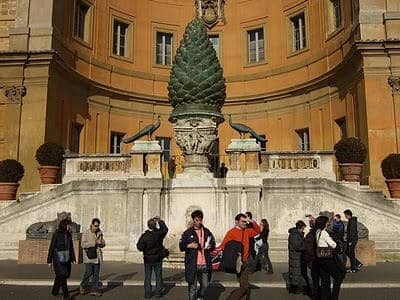 The Court of the Pigna, i.e.: "Court of the Pine Cone, Vatican" constitutes the northern end of the great renaissance Belvedere Courtyard that extended from the Papal Palaces to Innocent VII's "palazzetto" and was subsequently divided into three parts with the construction of Sixtus V's Library and the Braccio Nuovo of Pius VII. The present courtyard which takes its name form the enormous bronze pine cone set into the "nicchone", is bounded on the south side by the Braccio Nuovo, on the east by the Chiaromonti Gallery, on the north by Innocent VIII's Palazzetto and on the west by the galleries of the Apostolic Library.
The Court of the Pigna, i.e.: "Court of the Pine Cone, Vatican" constitutes the northern end of the great renaissance Belvedere Courtyard that extended from the Papal Palaces to Innocent VII's "palazzetto" and was subsequently divided into three parts with the construction of Sixtus V's Library and the Braccio Nuovo of Pius VII. The present courtyard which takes its name form the enormous bronze pine cone set into the "nicchone", is bounded on the south side by the Braccio Nuovo, on the east by the Chiaromonti Gallery, on the north by Innocent VIII's Palazzetto and on the west by the galleries of the Apostolic Library.
Pine Cone, Peacocks at the Court of the Pigna, i.e.: "Court of the Pine Cone, Vatican".  The peacock was associated with the Middle Eastern deity, Tammuz, consort of the goddess, Anat. In Greece, it was sacred to Hera, queen of heaven and lawful wife of Zeus -- a pair of them drew her chariot --, and they were kept at her temples. In the Roman Empire, peacocks were Juno's birds and on coins symbolized the females of the ruling houses, the lineage princesses. Juno WAS an ancient Roman goddess, the protector and special counselor of the state. Juno is a daughter of Saturn and sister (and wife) of the chief god Jupiter and the mother of Mars and Vulcan. Juno also looked after the women of Rome. Her Greek equivalent was Hera. Her Etruscan counterpart was Uni. As the patron goddess of Rome and the Roman Empire, Juno was called Regina ("Queen") and, together with Jupiter and Minerva, was worshipped as a triad on the Capitol (Juno Capitolina) in Rome. Juno's warlike aspect among the Romans is apparent in her attire. Juno often appeared sitting pictured with a peacock, armed and wearing a goatskin cloak. The traditional depiction of this warlike aspect was assimilated from the Greek goddess Hera, whose goatskin was called the 'aegis'. The aegis was the breastplate of Athena and Zeus, famously bearing Medusa's head, which, according to Homer was fashioned by Hephaestus "... and among them went bright-eyed Athene, holding the precious aegis which is ageless and immortal: a hundred tassels of pure gold hang fluttering from it, tight-woven each of them, and each the worth of a hundred oxen."
The peacock was associated with the Middle Eastern deity, Tammuz, consort of the goddess, Anat. In Greece, it was sacred to Hera, queen of heaven and lawful wife of Zeus -- a pair of them drew her chariot --, and they were kept at her temples. In the Roman Empire, peacocks were Juno's birds and on coins symbolized the females of the ruling houses, the lineage princesses. Juno WAS an ancient Roman goddess, the protector and special counselor of the state. Juno is a daughter of Saturn and sister (and wife) of the chief god Jupiter and the mother of Mars and Vulcan. Juno also looked after the women of Rome. Her Greek equivalent was Hera. Her Etruscan counterpart was Uni. As the patron goddess of Rome and the Roman Empire, Juno was called Regina ("Queen") and, together with Jupiter and Minerva, was worshipped as a triad on the Capitol (Juno Capitolina) in Rome. Juno's warlike aspect among the Romans is apparent in her attire. Juno often appeared sitting pictured with a peacock, armed and wearing a goatskin cloak. The traditional depiction of this warlike aspect was assimilated from the Greek goddess Hera, whose goatskin was called the 'aegis'. The aegis was the breastplate of Athena and Zeus, famously bearing Medusa's head, which, according to Homer was fashioned by Hephaestus "... and among them went bright-eyed Athene, holding the precious aegis which is ageless and immortal: a hundred tassels of pure gold hang fluttering from it, tight-woven each of them, and each the worth of a hundred oxen."
Pine Cone, Peacocks at the Court of the Pigna, i.e.: "Court of the Pine Cone, Vatican". 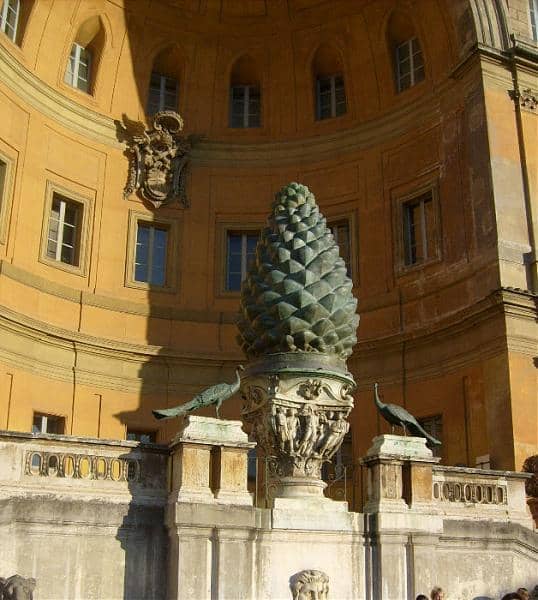
Pine Cone, Peacocks at the Court of the Pigna, i.e.: "Court of the Pine Cone, Vatican". 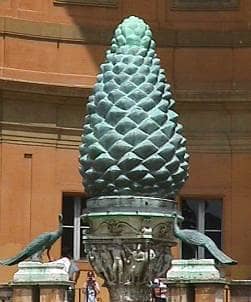 The colossal bronze pine cone was cast in the 1st or 2nd century by Publius Cincius Salvius who left his name on the base. Prior to being moved to the Court of the Pigna, i.e.: "Court of the Pine Cone," the jumbo pine cone was situated in the Campus Martius, in the area that is still called "Pigna", where it served as a fountain, water gushing from holes in the scales of the cone. Towards the end of the 8th century it was moved to the entrance hall of the medieval St. Peter's Basilica, in the center of the fountain covered by and ornate baldachin, identified in Renaissance drawings. Finally, in 1608, during the construction of the present Basilica, the giant pine cone fountain was dismantled and placed where it is today.
The colossal bronze pine cone was cast in the 1st or 2nd century by Publius Cincius Salvius who left his name on the base. Prior to being moved to the Court of the Pigna, i.e.: "Court of the Pine Cone," the jumbo pine cone was situated in the Campus Martius, in the area that is still called "Pigna", where it served as a fountain, water gushing from holes in the scales of the cone. Towards the end of the 8th century it was moved to the entrance hall of the medieval St. Peter's Basilica, in the center of the fountain covered by and ornate baldachin, identified in Renaissance drawings. Finally, in 1608, during the construction of the present Basilica, the giant pine cone fountain was dismantled and placed where it is today.
The Vatican at the United Nations, A Major Cause for Concern . . . .doc
, _picture_Daniel 2, Revelation 17, the antiChirst, Tony Blair A Biblical symbol thatis being used in conjunction with the European Union is the one from Revelation17 where a.htm
Who has 'precedence over' Ambassadors at the UN . . . The 'pope' at the United Nations . . . Church or State.doc
The colorful mural by Norwegian artist Per Krogh features prominently in the United Nations, UN, Security Council chamber. It depicts "the phoenix bird (Center of mural)" -- the symbol of Baal worship -- rising from its ashes, as a symbol of the world being rebuilt after the Second World War. 
Assyrian-Babylon winged god, Merodach or Marduk, known as Baal (Lord,) with a pine cone, representing power of regeneration, i.e.: new birth, which is traceable to Tammuz of Babylon. 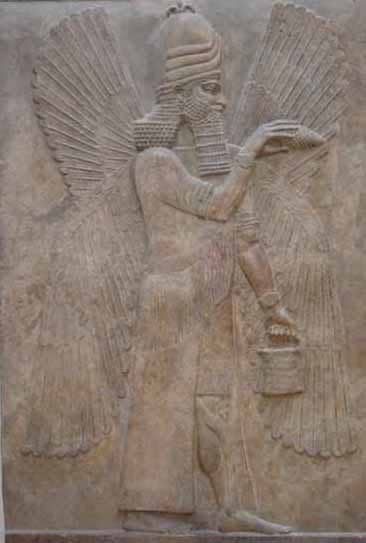
Pine Cone staff, "pope" Benedict 
"T" the mark of Tammuz (Baal) worship . . . Ezekiel 8:14.
The Church of the Nativity in Bethlehem . . .
is built over a cave that was originally a shrine to Adonis-Tammuz.
The Church Father Jerome, reports that the holy cave was at one point consecrated by the heathen to the worship of Adonis-Tammaz, and a pleasant sacred grove planted before it, to wipe out the memory of Jesus.
From Babylon this mystery-religion, what would become the worship of Tammuz spread to all the surrounding nations, as the years went on and the world was populated by the descendants of Noah. Everywhere the symbols were the same, and everywhere the cult of the mother and child became the popular system. Their worship was celebrated with the most disgusting and immoral practices. The image of the queen of heaven with the babe in her arms was seen everywhere, though the names might differ as languages differed. It became the mystery-religion of Phoenicia, and by the Phoenicians was carried to the ends of the earth. Ashtoreth and Tammuz, the mother and child of these hardy adventurers, became Isis and Horus in Egypt, Aphrodite and Eros in Greece, Venus and Cupid in Italy, and bore many other names in more distant places. Within 1,000 years, Babylonianism had become the religion of the world, as they had rejected the Divine revelation of Jehovah God.
Linked with the central mystery were countless lesser mysteries, the hidden meaning of which was known only to the initiates, but the outward forms were practiced by all the people. Among these were the doctrines of purgatorial purification after death, salvation by countless sacraments (such as priestly absolution), sprinkling with holy water, the offering of round cakes to the queen of heaven (as mentioned in the Holy Bible in the Book of Jeremiah, Jeremiah 7:18; Jeremiah 44:17-19; Jeremiah 44:25 angering the Lord of Hosts, dedication of virgins to the gods by having sexual relations with them in their temples, temple prostitutes (which was literally sanctified prostitution), weeping for Tammuz for a period of 40 days prior to the great festival of Istar (who was said to have received her son back from the dead); for it was taught that Tammuz was slain by a wild boar and afterwards brought back to life. To him the egg was sacred, as depicting the mystery of his resurrection even as the evergreen was his chosen symbol and was set up in honor of his birth at the winter solstice, when a boar's head was eaten in memory of his conflict and a yule log burned with many mysterious observances.
"T" the mark of Tammuz (Baal) worship . . . placed as ashes on the head of the follows of Tammuz, who was worshiped by the Jews even at the Temple in Jerusalem, Ezekiel 8:14, as part of their mourning for Tammuz. "Lent was not observed by the first century Church, but was first addressed at the church at Rome during the Council of Nicea in A.D. 325. Any doctrine contrary to the Roman Church was considered an enemy of the state. In A.D. 360, the Laodicea church commanded Lent to be observed. As time continued, more and more emphasis was placed on fasting…..from the fifth century on the observance of the fast was very strict. Only one meal a day was allowed: flesh meat and fish and even most dairy foods were strictly forbidden. Meat was not even allowed on Sundays. From the ninth century onward, Lent’s strict rule were relaxed. The emphasis was on performing “penitential works” than fasting and abstinence. Pope Paul IV (Febuary 17, 1966), “abstinence is to be observed on Ash Wednesday, and on all Fridays of the year that do not fall on holy days of obligation, and fasting as well as abstinence is to be observed on Ash Wednesday and Good Friday.” (Catholic Encyclopedia).
"pope" praying with head covered, against Holy Scripture, against the Word of God, the Holy Bible. Dishonoring his Head, the Lord Jesus Christ of Nazareth,
1 Corinthians 11:3-4.

"popes" praying with head covered, against Holy Scripture, against the Word of God, the Holy Bible. Dishonoring their Head, the Lord Jesus Christ of Nazareth,
1 Corinthians 11:3-4.
Pine Cone staff, "pope" John Paul, II. 
Scarlet colored Cardinal bows to and kisses the ring of, "pope" John Paul, II. Bishops wear purple colored vestments (cassocks) Revelation 17. The "pope" allows the bowing down to receive his worship. They claim to come from the Apostle Peter, but the Apostle Peter refused to accept this worship, as does even Angels: Acts 10:25-26; Revelation 22:8-10. Instead the "pope" Sitteth like a king, and acting as though he's a "god," 2 Thessalonians 2:4. Sitteth: Where the antiChrist rules, sitteth, means rules. Greek word for sitteth in Revelation 17:9 on which the antichrist sits, or takes to himself a throne:
kathémai: to be seated
Original Word: ????µa?
Part of Speech: Verb
Transliteration: kathémai
Phonetic Spelling: (kath'-ay-mahee)
Short Definition: I sit, am seated, enthroned.
Definition: I sit, am seated, enthroned; I dwell, reside.
Enthroned means: To seat in a place associated with a position of authority or influence, to seat ceremonially on a throne. The office and authority of a king or, occasionally a bishop. One having a crown, to hold in high regard; revere; exalt, anointed, glorified. To place a king, queen, etc. through the ceremony of sitting on a throne, to mark the official beginning of their period in power.
See: The Vatican at the United Nations, A Major Cause for Concern . . . .doc
The Vatican at the United Nations, A Major Cause for Concern . . . .doc
 _picture_Daniel 2, Revelation 17, the antiChirst, Tony Blair A Biblical symbol thatis being used in conjunction with the European Union is the one from Revelation17 where a.htm
_picture_Daniel 2, Revelation 17, the antiChirst, Tony Blair A Biblical symbol thatis being used in conjunction with the European Union is the one from Revelation17 where a.htm
 Daniel 2, Revelation 17, the antiChirst, Tony Blair A Biblical symbol thatis being used in conjunction with the European Union is the one from Revelation17 where a.doc
Daniel 2, Revelation 17, the antiChirst, Tony Blair A Biblical symbol thatis being used in conjunction with the European Union is the one from Revelation17 where a.doc
See:
 satanic images of the Vatican .htm
satanic images of the Vatican .htm
 satanic images of the Vatican, 2.htm
satanic images of the Vatican, 2.htm
 satanic images of the Vatican, 3.htm
satanic images of the Vatican, 3.htm
Revelation 6, verse 2, image of the 'pope' of Rome carrying (an idol of Jesus representing the arrow) as part of his crooked/bent cross, i.e.: bow . . . .htm.
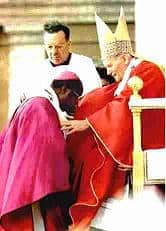
 Back to Paul Harrell's Sermon Notes.
Back to Paul Harrell's Sermon Notes.
 Back to Paul Harrell's Second page.
Back to Paul Harrell's Second page.
 Back to Paul Harrell's Home Page.
Back to Paul Harrell's Home Page.

Copyright © 2012 Paul S. Harrell